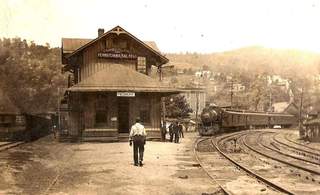 | Back to e-WV
| Back to e-WV
 The West Virginia Encyclopedia
The West Virginia Encyclopedia
 | Back to e-WV
| Back to e-WV
 The West Virginia Encyclopedia
The West Virginia Encyclopedia

The Mineral County town of Piedmont was named for its location at the foot of the Allegheny Mountains. Located on a bend of the North Branch of the Potomac River, Piedmont’s elevation is 871 feet.
Originally in Hampshire County, Piedmont’s history is closely intertwined with the development of the Baltimore & Ohio (B&O) Railroad, which crosses the river into Maryland just west of town to begin its long ascent to the Eastern Continental Divide. The B&O, which extended its main line through Piedmont in 1852, gave the town its start as it became the site of machine shops for the railroad. Additionally, Piedmont is located in the heart of the local coalfield. The town grew in the mid-1800s, from about 1,200 in 1855 to 2,000 in 1869. Piedmont was chartered in 1856.
Notable residents of Piedmont include industrialist and U.S. Sen. Henry Gassaway Davis (1823–1916), who lived in Piedmont early in his life as a storekeeper and railroad agent. The scholar and author Henry Louis Gates Jr. (1950– ), the Alphonse Fletcher University Professor and the Director of the W. E. B. Du Bois Institute for African and African American Research at Harvard University, grew up in Piedmont.
Throughout the 20th and early 21st centuries, a major employer in the Piedmont area was the paper mill in nearby Luke, Maryland, but it closed in 2019. The Luke mill was founded in 1888 as the Piedmont Pulp & Paper Company, later operating as West Virginia Pulp & Paper and other names after various acquisitions.
Piedmont’s population peaked in 1920 at 2,835 and then started a fairly steady decline, which began accelerating in the 1960s. In 2020, Piedmont’s population was 716.